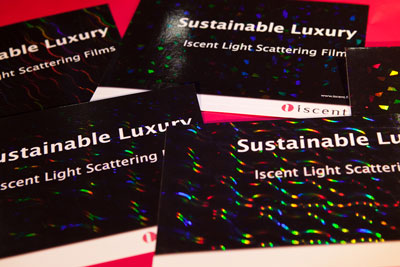| Jan 18, 2013 |
Film surface modification technology goes global in the printed intelligence sector
|
|
(Nanowerk News) A cost-effective, sustainable solution for producing flexible film with no metal, extra lacquers or lamination has been introduced by Iscent, a Finnish start-up company based on technology from VTT Technical Research Centre of Finland. The film surface modification technology enables the production of holograph-like images for plastic and fibre-based film materials. Iscent's new extra-wide production line enables large-volume production of new kinds of products with minimised raw material costs.
|
|
At the end of 2012, Iscent made a significant investment in a wide web (1,200 mm) roll-to-roll production line that uses the film surface modification technology. The wider line offers many interesting opportunities for printing, but is especially developed to meet the needs of new consumer package solutions, such as wrappings, flexible packages and labels. Commercial holograms in the printing industry are often printed on narrow-web lines; this makes the new production line very competitive.
|
 |
| Hot embossed light scattering effects made on printed carton.
|
|
The wider processing line can be installed easily, either as a part of the traditional printing line or working alongside it. The production speed meets the requirements of traditional printing lines, and tailored extra effects can be produced directly on to the surfaces of flexible films and papers.
|
|
Iscent plans to go global, with several technology package deals and production sites anticipated in packaging and printing houses within the next few years. The focus markets are Europe, Russia, the USA and Japan.
|
|
Applications from self-cleaning surfaces to brand protection
|
|
The film surface modification technology is applicable in a wide range of markets. The technology is particularly expected to fire up global brand owners looking for additional effects for their products or better methods against counterfeits. Being free of additional material, the process is also suitable for food packaging applications. Other applications can be found in microfluidics, in-mould plastic inserts and decorative interior products. Future products being planned include micro- and nano-level surface modifications to create tailored, decorative, tactile and self-cleaning surfaces for consumer products.
|
|
The holographic appearance can be produced ecologically - an important consideration for many consumers and manufacturers nowadays. The new technology offers products a new edge, with light-scattering effects produced without the traditional cost-consuming varnishes and metals.
|
|
Film surface modification technology is a satisfying example of the impact of VTT innovation on packaging development, and reinforces the valuable link between quality research and commercial development.
|

